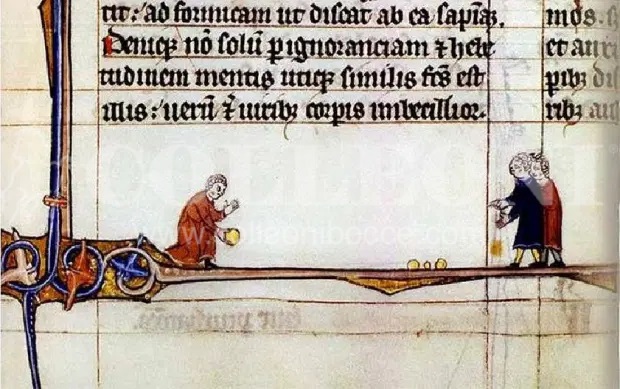
The Greeks and the Romans used to play bowls.
One of the earliest written documents mentioning this game is the greek physician Hippocrates (460-377 BC), who praises him and the board holds a very healthy.
The leap in quality of the balls is still due to the Romans who adopted, first, wooden balls. For Ovid was the favorite pastime during his exile on the Black Sea, there delighted the emperor Augustus (who used olive burl bowls), Pontius Pilate and Claudia also Galen, who, like Mr Hippocrates, advised him young and old.
The Roman legions did know the game in Gaul and Britain, where, later, had a huge development.
In the Middle Ages, this game became a craze. It was played in the streets, squares, castles. The bowls fascinated everyone, nobles and plebeians. It was not disdain the church and the ladies. In 1299, in Southampton (the Roman Clausentum), England, was born that we can consider the first club boccistico: The Old Bowling Green.

Take kindly to having the balls were also Dutch humanist Erasmus of Rotterdam (1466-1536, called the “ludus globorum missilium”), the German theologian Martin Luther (1483-1546) and Calvin (1509-1564, was also a avid player).
The writer Rabelais Gargantua in 1532 told us how to practice this game to digest. Bruegel the Elder immortalized in his famous painting of children Games (1559) exhibited at the National Art Gallery in Vienna. Sir Francis Drake he was a real buff.
In 1588, warned of the arrival of the Spanish fleet, the famous “Invincible Armada,” he continued quietly to play bowls on the docks of the port of Plymouth decided, before sailing to defend England to finish his game with un’incertissima boatswain.
Bocce speaks William Shakespeare in his Richard II (1595). The game, however, continued to worry the authorities. In 1576 the Doge of Venice, they were even scared and issued an edict against heavy “… the danger of big bales ….” But they were practically the last anathemas against a game that, by now, had spread throughout most of Western Europe. In fact, towards the end of the seventeenth century, Charles II of England was legalized, and even he arranged for a sort of regulation.
In 1753, in Bologna, he published a booklet, the “skittles” Raffaele Bisteghi, which formalizes this game popular and, with countless variations, also regulated.
On 1 May 1873 the first company was founded in Turin in Italy who took the curious name of Crack Bowls. It was the first step, the first brick of the future national organization. A quarter century later, in 1897, a group of companies bowling Piedmont met in Rivoli, near Turin, and he decided to establish a coordinating body of the territory. Thus, on 1 May 1898, in Turin, the International Exhibition, was born the Union Bowling Piemontese, practically the first federation which began the modern stage of the game of bowls.
Advances were immediate. In 1904, he established the first official game of the technical regulations. The activity was carried out only with the open, on fields that are not marked, with wooden bowls. The ball was born in France “spike”, the ancestor of the metal.
UBI was born in 1919, Union Bowling Italian, the heir to the Piedmont. The new body, based in Turin, was led by Advocate Massimo Cappa.
The 1924 was another historic day. For the first time, with a demonstrative presence, the balls landed in the Olympics. The games took place in Paris where, at the same time, we played a tournament between teams from the Italian, French and Monegasque.
In 1926 the Olympic Committee recognized the UBI. It was an important milestone for the bowls that were seen as equivalent to other sports. But the euphoria did not last long.
In 1929 a ministerial decree moved the balls by CONI wave, the OND, they considered a recreational activity. In the new context, while outdated, however, the petanque found a real and substantial unification of the country and began an extensive peripheral organization. Also adopted was a single technical rules of the game in Italy.
In 1929 there was an important breakthrough with the birth of the ball “synthetic”, a sphere, mixed with sawdust and glue.
In 1945, after fascism fell, the OND dissolved, whose functions passed to ENAL, the National Workers Assistance Body.
During the post-war period the game of bocce had a very troubled life. Many federations were born which, only in 1948, found an agreement and gave birth to the UFIB “Union of Italian Bowls Federations”.
It grouped the two main game systems practiced in Italy. The “raffa” spread practically all over the national territory and which also considered the recreational aspect of the game. The “volo” which, firmly rooted in Piedmont and Liguria, focused above all on the competitive aspect.
The headquarters of the Federation was set in Genoa and the two game systems were coordinated by two sections. The SeReNa “National Regulation Section” for the raffa game, based in Milan. And the SeReInt “International Regulation Section”, also based in Genoa, which managed the volo game.
In 1946 the International volo Federation was born, in 1950 that of the raffa.
In 1979 all the bocce of Italy were rewarded for their willingness to unite under a single acronym: the UBI. It obtained the immediate recognition of CONI. In 1985 the World Confederation was born and obtained the recognition of the IOC the following year.
The Italian bocce adopted a new statute in 1991. They were identified by a modern logo: blue bowl in movement with tricolor curl. They took the name of FIB: Italian Bowls Federation.
On February 28, 1993 Romolo Rizzoli was elected to the presidency of the FIB. The sport of bocce, thanks to the decisive support of the Italian FIB and CONI, contributed to the organization and participated unofficially in the Mediterranean Games in Montpellier, France. The following year, the FIGP (Italian Petanque Game Federation) joined the FIB.
The sport of bocce took part officially in the Mediterranean Games in Bari and in the World Games in Lathi, Finland in 2007
Romolo Rizzoli was elected president of CBI, the raffa international. Two years later he joined the CONI Executive Board. In 2001 the first periodic transmissions of the bowls on Rai TV began. In 2004 there were two important events that made the FIB make a qualitative leap. The first was the laying of the foundation stone of the Federal Technical Center of Rome, a world-wide work. The second was recognition by the government as a federation for welfare purposes. This was a legislative act that brought significant economic benefits to companies.
In 2006 Rizzoli was elected president of the World Bowls Sports Confederation (CMSB). Also in that year, China organized a women’s world volo championship for the first time. On that occasion Italy won two gold medals.
Rizzoli was re-elected for the fifth time (2009) to the top of the FIB. In that year, Italy put itself on display by organizing the first women’s world championship (raffa and volo). It took place in Bevagna (Perugia) and participating, with all specialties, in the Mediterranean Games in Pescara and in the World Games in Taiwan.
On March 19, 2010, the Federal Technical Center of Rome was inaugurated, the citadel of the petanque sport in the Eur area which, in terms of size and functionality, is a unique structure in the world. Italy, which has been practically the cradle of the game since Roman times, has always played a leading role worldwide. Throughout 2016, the blue shirts earned 295 gold medals on the fields of the World Games, the Mediterranean Games and the European and world championships. A milestone never reached by any other football federation in the world.
In March 2017, the national assembly was held in Verona, the first in the history of Fib, with direct vote of the companies. With a large majority, Marco Giunio De Sanctis was elected to the presidency.
(source FIB www.federbocce.it)